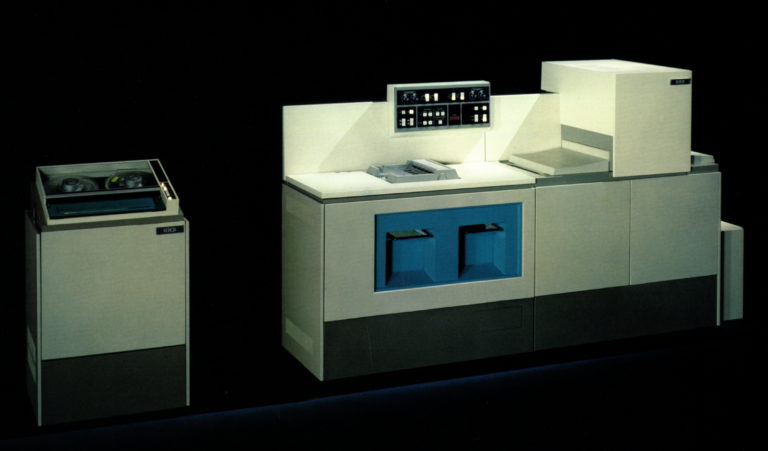Written by Fred Ramsey
Worldwide Marketing Product Manager, Xerox Corporation
Do you know the significance of today? If you were wearing your mathematical cap this morning when glancing at your mobile device or calendar, perhaps you associated today’s date, March 14th (3.14) with Pi Day. Pi, the Greek letter π, is the symbol that is used to represent a constant that is the ratio of a circle’s circumference to its diameter. As an irrational number, the digits beyond its decimal point continue infinitely without repetition or pattern.
There are many unique ways to celebrate Pi day; observing the history of pi, baking and eating pies (blueberry is my personal favorite), telling pi jokes, seeing how many digits of pi you can memorize (my son has memorized 27 decimal places)…the list goes on, much like pi itself.
The Xerox Color 560/570 Printer has found its own unique and fun way to celebrate National Pi Day, highlighted by a print application printed on 11”x17” (279.4mm x 431.8mm) paper, complete with more than 500,000 digits of pi, in 0.6 font contained within a 6” x 13” area. We’re talking about text that is just 1/100th of an inch high and requires a magnifying glass or loupe to legibly read.

This print sample with its insanely small text illustrates much more than just some fancy magic trick you can whip out during cocktail hour to impress your friends. Think of the real-world usages enabled through the Xerox 560/570, its outstanding image quality with 2,400 x 2,400 dots per inch (DPI) print resolution and the patented Xerox specialty imaging security print technology, such as:
– MicroText (text printed at smaller than 1 point size)
– Correlation marks (printed text that is only visible when superimposed by a ‘key’ overlay)
– GlossMark text (printed text that isn’t visible on straight-on view but becomes visible under inclined illumination)
– FluorescentMark/InfraRed text (printed text that is only visible under UV/black-light or in the dark with an infrared camera)
All of these specialty imaging technologies provide outstanding opportunities for you to provide your customers with applications rich with security features, such as coupons, tickets, ID badges for university students or employees, and invoices.
The ability to print such small text is a good example of the 2,400×2,400 DPI of the Xerox 560/570 in action, offering incredible production capabilities and image quality at a value price. As you can imagine, there are real-world benefits to being able to address the smallest of dot sizes. Greater print resolution and more accurate dot control allows for even print coverage and better density while using less toner. And by using less toner, supplies costs are kept in check. With special polyester EA low melt toner, the 560/570 output fuses to polyester in a chemically bonding way, ensuring outstanding image quality on specialty substrates such as plastic, polyester and more.
What digital print applications do you think are prime examples to effectively utilize specialty imaging and security print technology?
Interested in more topics similar to application ideas, the Xerox Color 550/560, and security printing? You may like:
22 Comments
Comments are closed.



I’m a teacher and I think security printing could be utilized in printing answer sheets for standardized tests; encoding students’ names and other info into the answer sheet so cheating and other fraud becomes more difficult.
I can see this print technology being used for making onsite ID badges for schools and businesses, doing things like putting ID numbers and names into a “decorative” border on the badge.
It would also make printing event tickets for smaller events more secure and cost effective, allowing the venue to encode the date, ticket number and other information into borders and putting more detail into the venue logo. It would also allow adding Easter eggs in the way of hidden quotes and trivia to make the ticket more fun for the customer, and make them more likely to hang onto it as a memento of the event (and advertising for the venue in the process!)
How about small lot printing of personalized, scannable marketing identifiers, such as QR codes?
I think the in-house industry could make great use of this technology — in many of the ways already listed but also with many internal communications or even external client promotions. The promotion could allow for certain documents to be printed with the winning information but the client would attend and event/trade show/sales call to have their piece magnified/viewed to determine if they’ve won.
Using less toner not only saves money, but is better for the environment. There is less waste to be recovered and shipped as well as fewer shipments to restock.
Very cool. I really like the idea Tim K provided of using this technology to prevent student cheating.
Wow. There are hundreds of uses for this process. Perhaps as a competition … Find the clues hidden in a brochure mailing…
The quality it will produce should make prints photoquality (if it can resolve microsize type the ability to render incredible half tone.
Coming from the plastic card industry, I have seen tremendous advances in security technology and creativity (from RFID, to Smart Card technology, to creative uses of barcodes). From an ink-on-paper perspective, I believe there are now unique ways to communicate information and even track responses with digital printing technology and security features. One of those would be to incorporate this technology into games/sweepstakes/offers unique to the individual that can be played/redeemed by smartphones.
As for ticket printing and decorative cards is great, as is a graphical tool that made the most, I love her.
Very cool…can be used for multiple purposes. The first that comes to mind is security. Not only tech, but also personal property tagging etc.
Ha. I can see this as a great way for coupon and promotions provides to list out their lengthy rules and restrictions, to make them even less legible, unless of course you have this nifty little magnifying glass.
Use it as part of a Print Your Own Giftcard kiosk that includes vendor branding, purchase location encoding, and unique identifiers – photo id? Incorporate CreditCard POS to add whatever dollar amount you wish.
FluorescentMark/InfraRed text could really be valuable to authenticate original documents in estate planning. Wills, trust and such may not be easily changed.
I think it would be fun to incorporate microprinting into school projects and things that are more fun in nature. I am an RIT student and have taken many print and photo classes. This could add a whole new artistic dimension to these projects.
Universal ID, anyone?
This would be a good use for archiving documents, like the microfiche for newspapers, as the digital copies we have stored may eventually degrade (anyone had a hard drive fail?). Also, for digital watermarking of technical drawings – embedding text within lines to hold additional information.
This would be great for blueprints. Architects, electricians, general contractors already try to print tiny on small blueprints, Now they can with less duplicate pages.
Gloss mark can be used for catching an eye of passerby (angle of viewing changes when walking past document hanging on the wall).
The ideas are interesting. Using as microfiche is possible. You can print this on Polyester—so the life is >50 years and the fine, grown, EA toner bonds to the Polyester like crazy.
I also really like the idea of forming the detailed 0.6 font into a shape in itself. So, in my example, the Greek character “Pi” could be formed up of all the numeric decimal places….I might try building shape formed of the numbers and sharing again for Pi Day 2014!
Fred (Xerox Employee)
Wow! The great ideas are piling up here – thank you to everyone who has shared so far!
John and both Amy’s bring up interesting ideas with enhancing the value and experience for the end user by embedding the security MicroFont into the printed piece for prize redemption or promotional purposes. Amy (Comment 2) and Rick – you may both find great interest in an upcoming blog post we will be sharing, featuring a print application making use of MicroFont, FluorescentMark, InfraRed text, and Correlation Marks. You’ll want to stay tuned for sure – it’s very unique!
Bill (Xerox Employee)
This is amazing! The digital side of the printing industry just seems to be growing at a rapid non stop rate. But I prefer litho / offset printing as I often have more control when something breaks on a machine, let’s face it, is there really a digital machine out there that can spit out 130 A1 sheets of 350gsm stock per minute?
Hey Christopher, while you bring up a good point – the advancements in print technology, especially the pace at which they occur, surely make anything seem plausible in the future. You never know!
Thanks for sharing – and glad you enjoyed the real-world example of MicroFont technology!
Bill (Xerox Employee)